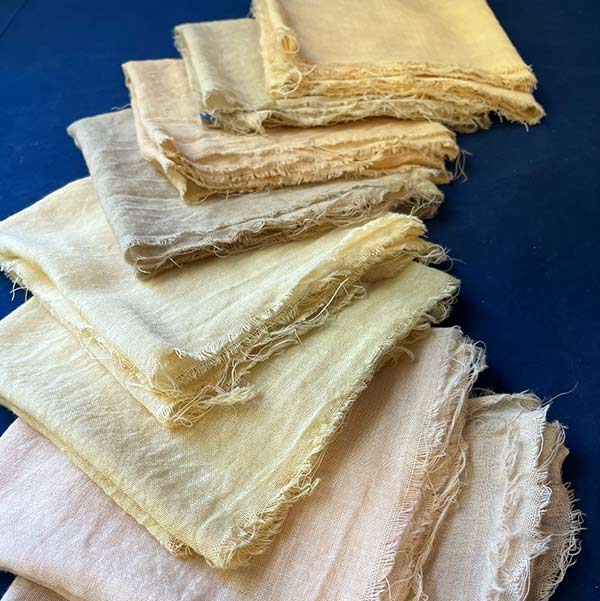Sarah Tremaine is a textile artist, dyer and environmental scientist in Virginia who lives on that farm and did lots of tests and experiments with fruitwood trimmings as part of her own practice and shared the results with us.
We quickly became enamored of the wonderful shades, and were able to get some boxfuls of her annual pruning and trimmings for your next dye exploration. These are bark chips, twigs and buds from four trees: cherry, apple, pear, peach, apricot and plum, and the colors are blossom soft and aromatic.
Fiber Preparation and Mordanting
We offer scouring and mordanting instructions for wool, alpaca, silk (protein), cotton and plant (cellulose) fibers. Your fiber should be scoured and mordanted before dyeing. Different fibers will yield different colors. We used wool gauze mordanted with aluminum sulfate and got some lovely, soft shades.

Extracting the Dye
Use 100-200% on the weight of fiber (WOF) and soak the chips overnight in water. The next day, simmer the chips for 1-2 hours to extract the dye bath, let cool, and carefully strain, reserving the strained liquid for your dye bath.
Adding Fibers to the Pot
Fill the dye pot with water so that the fibers move easily. Add the extracted liquid and stir well. Add the wet, mordanted fibers to the cold dye pot and begin heating the water. Let simmer for 45 minutes or longer, rotating the goods regularly. Longer simmers will yield deeper shades. An iron postbath will create greenish gray to medium gray colors to extend the palette.
Rinsing
Using the same temperature water as your dye bath, rinse the dyed goods once or twice to remove excess dye, then wash gently in a neutral liquid soap. Dry away from direct sunlight.
Reusing Dye Baths and Disposal of Dye
Any exhaust baths with dye color left in them may be used to dye additional materials. I keep extra small skeins of mordanted wool yarn and throw those into the exhaust baths. There will usually be some residual color in the dyebath, even after using the exhaust bath. Dispose of the used dye baths in accordance with your local municipal guidelines. Fruitwood chips can be saved to extract color from again, used for eco-printing, or composted after use.
